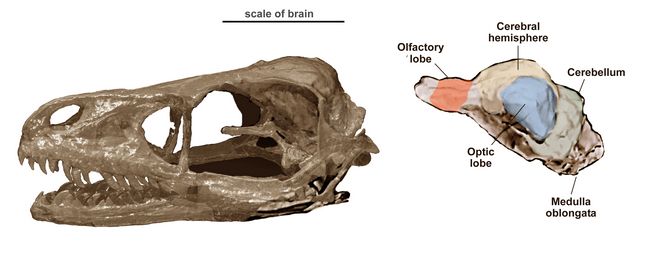Athena Review Image Archive ™
Bambiraptor skull and brain

Skull and brain of Bambiraptor (after )
Bambiraptor was a Late Cretaceous (72 mya), bird-like dromaeosaurid dinosaur. The Bambiraptor
holotype skeleton, representing a juvenile with a total length of 1 m,
was discovered in 1993 near Glacier
National Park in Montana by a teenage fossil collector. Adult
specimens haved also been found,with adult body length estimated at 1.3
m, with a weight of five kg. It
had long hindlimbs, indicating it could have been a fast runner, and
very long arms.
Bambiraptor had a relatively large brain size, in the lower range of modern birds. The Bambiraptor holotype had with 14 cm³ the largest brain for its size of any dinosaur yet discovered, although the brain size may be due to its age, because juvenile animals tend to have larger brain-to-body ratios compared to adults.
Because of its enlarged cerebellum, which may indicate higher agility
and higher intelligence than other dromaeosaurs, Burnham et al.
(2000) proposed that Bambiraptor may have been arboreal. Life
in the trees may have required evolutionary pressure that resulted in a
larger brain. An alternative hypothesis is that a
larger brain could be selected for as a result of hunting more agile
prey items such as lizards and mammals.
References:
Burnham,
D.A., K.L. Derstler and W. Linster 1997, A new specimen of
Velociraptor (Dinosauria: Theropoda) from the Two Medicine Formation of
Montana. Dinofest International Proceedings. pp 73-75
Burnham,
D.A., K.L. Derstler, P.J. Currie, R.T. Bakker, Z.Zhou Z. & J.H.
Ostrom 2000. Remarkable new birdlike dinosaur (Theropoda:
Maniraptora) from the Upper Cretaceous of Montana. University of Kansas Paleontological Contributions 13: 1-14
.Copyright © 1996-2020 Rust Family Foundation (All Rights Reserved).